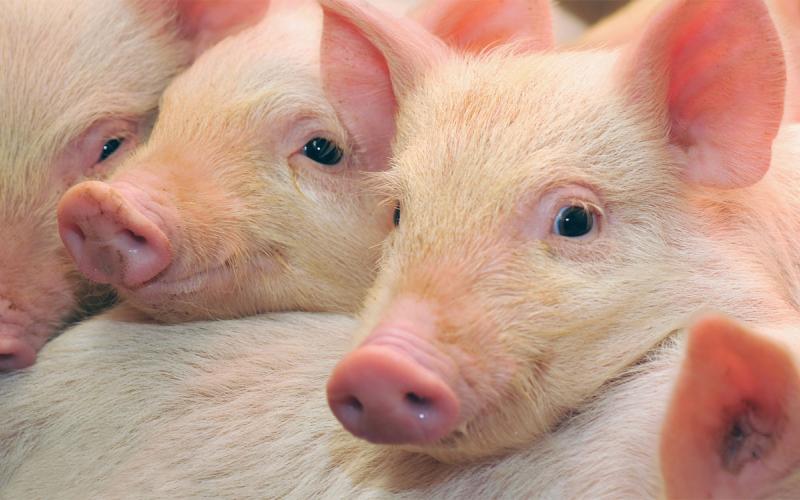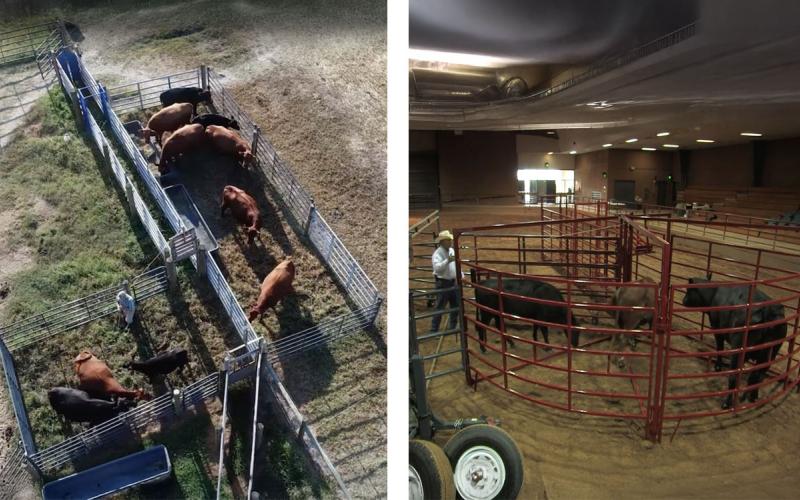
Written collaboratively by Ryan Samuel, Xufei Yang, Casey Zangaro and Joe Darrington.
Within swine production barns, the management and mastery of ventilation systems can be viewed as both a science and an art. As the days change throughout the year, the ventilation requirements at the barns also shift. The challenge lies in balancing the indoor environmental conditions with the varying needs of the pigs, such as age of the pigs, health status, breed, and growth rate; the management is not as simple as pressing buttons and hoping for the best. Ventilation management is the act of utilizing air flow to alter the indoor environment, animal behavior and comfort. Ventilation must be properly maintained for the best production practices to yield optimal animal growth and production.
The major components of mechanically ventilated buildings include fans, inlets, heaters, and a mechanism to control the system. Each of these can be centrally controlled or have their own set of controls that work together to change the environment within the barn. In negative pressure systems, the ventilation air flows into the barn via inlets and is pushed out by fans. The goal of a well-controlled ventilation system is to limit moisture accumulation in the winter and heat rise in the summer, while maintaining an appropriate temperature and humidity level for pig health and performance.
Fans
Ventilation fan stages are an important factor to design and control well in mechanically ventilated systems. These stages need to match the air flow that moves through the animal space to balance the heat and moisture coming off the pigs. As pigs grow, they produce more heat and moisture per head, since bigger pigs means more heat and moisture to withdraw from the facility ventilation rates increase through the growing period if the outdoor environmental conditions are similar. However, the difference between indoor and outdoor, temperature and humidity conditions, can also impact ventilation requirements and the staging of fans. Fans are rated by the cubic feet of air per minute (cfm). The cfm of a single fan depends on the horsepower of the motor, rpm of the motor, shape of the blades, the design of the shroud around the blades, the static pressure the fan is working against, and the level of repair or disrepair. It can be difficult to determine the exact cfm flowrate of a fan’s capacity within each specific swine facility.
The first phase of ventilation is considered the minimum stage. The most-utilized fans are pit fans, which provide a base level of air exchange throughout the barn; they maintain a base level of airflow to provide proper air quality and moisture control. The next stages act to continuously increase the rate of air flow out of the barn as more fans are engaged and higher air flow rates are employed. These fans are typically controlled by a connecting thermostat regulator or ventilation controller which automatically activates them if the barns conditions require them. Inside temperature is the most commonly used data point to control ventilation stages because sensors are robust and relatively inexpensive. Fan stages above the minimum are turned on at specified temperatures above the set point temperature (desired temperature) of the room or barn, Table 1. illustrates an example of a 5-stage system utilizing single-speed fans.
| Fan Stage | Set Point Temperature |
Indoor Temperature = Stage On |
Indoor Temperature = Stage Off |
|---|---|---|---|
| 1 | 70 °F | Always on | Always on |
| 2 | 70 °F | 72 oF | 70.5 oF |
| 3 | 70 °F | 74 oF | 72.5 oF |
| 4 | 70 °F | 76 oF | 74.5 oF |
| 5 | 70 °F | 78 oF | 76.5 oF |
Static Pressure
A very important and sometimes overlooked concept in ventilation systems is the concept of static pressure. The static pressure is the relative pressure found inside the building when compared to the pressure outside the building. Appropriate mixing of incoming air with the ambient barn’s air is achieved via static pressure by influencing the velocity at which air enters the airspace through inlets. With proper static pressure, outside air will enter the barn airspace at a target velocity of 800-1000 feet per minute (fpm) and result in favorable and complete mixing patterns in a barn. Often, barns with negative pressure have a static pressure between 0.05 to 0.12 inches of water. The biggest issue with static pressure within a negative pressure system is air leakage into the barn. This creates a problem, because it is not being controlled (infiltration) and can cause low static pressure. This decrease in static pressure and resulting decreased inlet airspeed can limit the amount of air distribution that occurs due to the designed inlets. Alternatively, as static pressure increases, the fan’s cfm or air delivery capacity decreases. This creates issues with the efficiency of fans under high pressure loads and decreases the airflow rate through the barn which can lead to improperly ventilating the barn.
Inlets
Inlets in negative pressure barns are commonly referred to as continuous slots, boxes, or area inlets. Location and size of theses inlets are crucial for proper barn ventilation. Some further considerations for inlet locations are building width, air intake for both cold and hot weather, and air entering across the ceiling versus down the side walls of the building. Inlet spacing and total inlet area affect the static pressure and air velocity which is vital for proper air mixing within the barn. Ideally, you want to make the total air inlet area proportional to the total fan capacity. Inlet air speed is critical to prevent drafts and dead air pockets within the barns. Air speed is controlled by open or closed spaces around the inlets which typically operate under automatic control in most conventional swine barns. Ideally, the target inlet speed for a swine barn is 800-1,000 feet/second as this corresponds to the desired static pressure in the barn.
Calculating Optimal Ventilation
For many livestock production managers and owners, the calculations and measurements of the different ventilation components are unknown and can lead to revenue losses within the industry. However, knowing these few calculations could potentially save these barns money and create a better environment for livestock. To do these calculations an individual will need to know a few details, such as the number of pigs, age, weight, type of operation, and external environment. From knowing these details and having a MWPS-32 Mechanical Ventilation Systems for Livestock Housing handbook, a manager can predict the required number of fans, stages, number of inlets, and percent openings/stage. From Table 2. Recommended Mechanical Ventilation Rates found in the handbook, a manager can replicate a similar table required to calculate optimal ventilation, while taking types of operation, number of animals, and internal and external temperatures into consideration. For example, first the total cfm required for the total number of animals at each of the different combinations of outdoor weather and animal weight. The lowest number obtained from this calculation will be the minimum ventilation rate while the highest number will be the maximum ventilation rate required for that facility. Next you figure out the number of fans needed for the specific facility and the stages needed for each phase of production. (see sizing fans article) Third, you find the required number of inlets and percent opening for efficient ventilation, it is recommended to have a target inlet speed, usually between 800-1,000 feet/second. To figure the total inlet area in the building for each stage you divide the flowrate (cfm) by the target air inlet velocity (ft/min) to get the square feet of inlet opening required to ensure target inlet air speed. From this, the number of inlets required to provide efficient minimum and maximum ventilation rates for the livestock can be calculated based on the minimum and maximum opening of a factory inlet.
To figure the percent opening per stage of ventilation, the maximum and minimum area opening should be obtained from the inlets being used. This information needs to be in ft2. The minimum cold ventilation rate can be obtained from the lowest total inlet area within the building; it is then divided by the minimum area opening for the particular inlet being used. The same will be required for the maximum hot ventilation rate/maximum area opening for the inlet. To find the total inlet percent opening, divide the total inlet area required within the building by the total available inlet area that will be in the barn.
In Summary
By simply knowing these ventilation formulas, anyone can quickly calculate the needed fans and inlets and can troubleshoot issues to efficiently manage the environment within the barn. Ventilation systems have the potential to maximize swine production with regard to animal growth and performance and understanding the rationale behind their design can help any manager do the best job possible. Please view the Producer Ventilation System Planning Worksheet below for an example and empty worksheet for use in any finishing barn or room.


